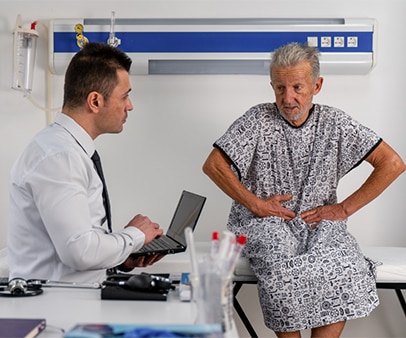Sports Hernias: Common Symptoms, Potential Causes, Diagnosis, and Treatment
Did you know… Approximately 5% of adult athletes experience sports hernias every year? But, you don’t have to be an athlete to experience a sports hernia.1
About Sports Hernias1,2
A painful, soft tissue injury that occurs in the groin area, a sports hernia (known by the medical community as Athletic Publagia) most often occurs during repetitive, explosive motions that require sudden changes of direction or intense twisting movements.3 They’re typically seen in activities that involve planting the feet and twisting with maximum force and exertion, such as:
- Ice hockey
- Soccer
- Football
- Wrestling
- Rugby
- Skiing
- Tennis
- Hurdling
However, while a sports hernia may lead to a traditional inguinal hernia, it is technically a different injury.2
- Inguinal Hernia: When abdominal tissue, such as part of the intestine, pushes through an opening in the lower abdominal wall, creating a painful bulge.
- Sports Hernia: A strain or tear of any soft tissue (muscle, tendon, ligament) in the lower abdomen or groin area where the abdominal and adductor muscles attach at the pubic bone due to physical activity.2
Symptoms of Sports Hernias1
A sports hernia will usually cause severe pain in the groin area at the time of the injury. The pain typically gets better with rest but flairs back up when you return to sports activity, especially with twisting movements.
Unlike more common inguinal hernias that cause a visible bulge in the groin, sports hernias don’t typically show any outward signs. However, over time, a sports hernia may lead to an outward bulging inguinal hernia. Without proper treatment, it may result in chronic, disabling pain that prevents you from resuming sports activities.
If you have symptoms of a sports hernia, contact your doctor as soon as possible to have it diagnosed and to rule out other possible causes of pain.
Common Causes of Sports Hernias1
A sports hernia happens when the deep layers of your lower abdominal wall or the tendons that attach muscles to your pelvis weaken or tear due to physical activity. Common causes may include:
- Forceful and repetitive hip movements (twisting, kicking, jumping, cutting/slicing).
- Vigorous and unsafe abdominal and hip exercises.
- Weakness in the abdominal muscles and a lack of proper sports conditioning.
- Imbalance in strength between your hip and abdominal muscles.
Ways to Diagnose Sports Hernias1
To identify whether or not you have a sports hernia, your healthcare provider will likely speak with you about your symptoms, how the injury occurred, and proceed with a physical examination. You will likely be asked to do a sit-up or flex your torso against resistance. If you have a sports hernia, these tests will be painful. Additionally, your doctor may use imaging techniques such as:
- X-rays
- Magnetic resonance imaging (MRIs)
- Bone scans
- Ultrasound
- CT scan
Treatments for Sports Hernias1,2,3
Specific treatment for a sports hernia will be determined by your doctor and depend on many factors, including the severity of your symptoms, general health, and location of the hernia.
Non-surgical Treatment
- Ice and Rest: In the first 7 to 10 days after the injury, treatment with rest and ice can be helpful.
- Physical Therapy: Two weeks after your injury, your doctor may recommend that you do physical therapy exercises to improve strength and flexibility in your abdominal and inner thigh muscles.
- Anti-Inflammatory Medications: Your doctor may recommend non-steroidal anti-inflammatory drugs (NSAIDs) or corticosteroids to reduce swelling and pain.
Surgical Treatment1
If rest and conservative treatment do not work, your doctor may discuss the surgical procedure(s) with or without the use of mesh to repair the torn tissues.4 These procedures may include:
- Open: The traditional method for hernia repair, open surgical procedure involves your surgeon making one long incision.
- Laparoscopic: A minimally invasive technique, your surgeon will make several smaller incisions. Through one “key-hole,” he/she will insert a thin tube with a video camera attached. Repairs will be made through the other incisions using thin instruments that are guided by the camera.
- Inguinal Neurectomy: The cutting of a small nerve in the groin (inguinal nerve) during surgery to relieve the patient's pain.2
Recovery From Surgical Treatment for Sports Hernia
Approximately 90% of surgeries, both open and laparoscopic, to fix sports hernias are considered successful.1 With post-surgery physical therapy and rehabilitation, people with a sports hernia can usually fully return to their sport or activities between 6 and 12 weeks.1 In some cases, the affected tissue can tear again once you return to sports activity. If this happens, surgical repair will most likely need to be repeated.1
It is important to follow your doctor's instructions about when you can return to physical activity, and which activities are appropriate for your individual condition. Individual results vary, and not all patients will return to the same activity level.
The guidance provided in this article follows general rules that should be discussed with your doctor. This article is for informational and educational purposes only. It does not substitute for medical advice. If in doubt, always consult your doctor.
Related Articles
Join the HerniaInfo.com community! Get notified about our latest articles and updates on all things hernia as they become available.


